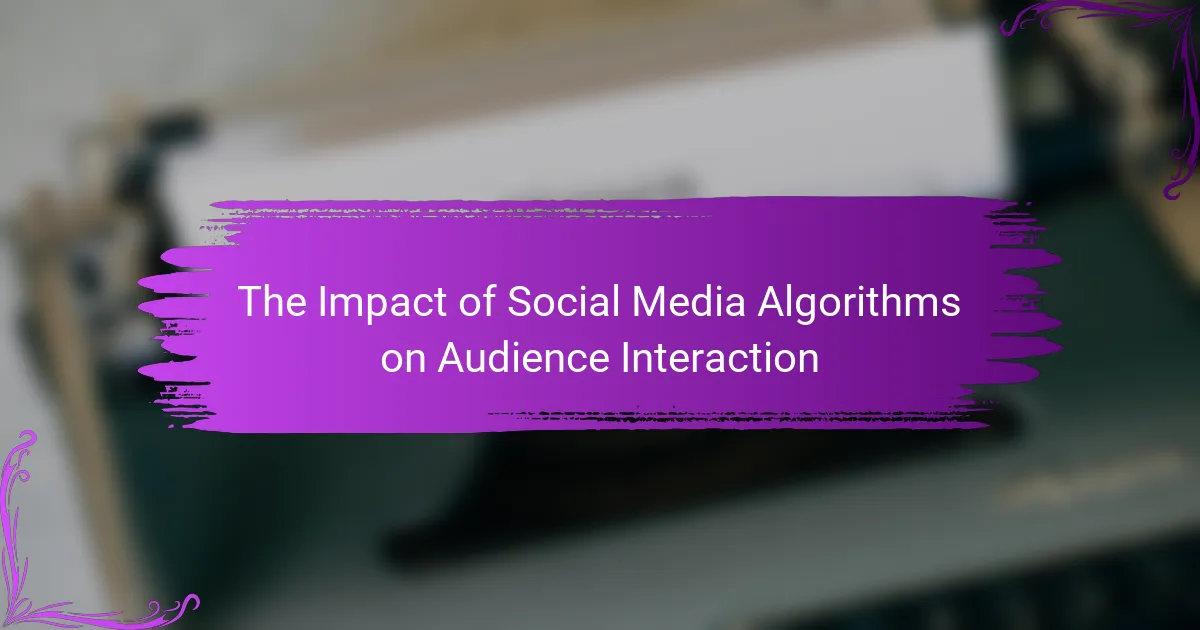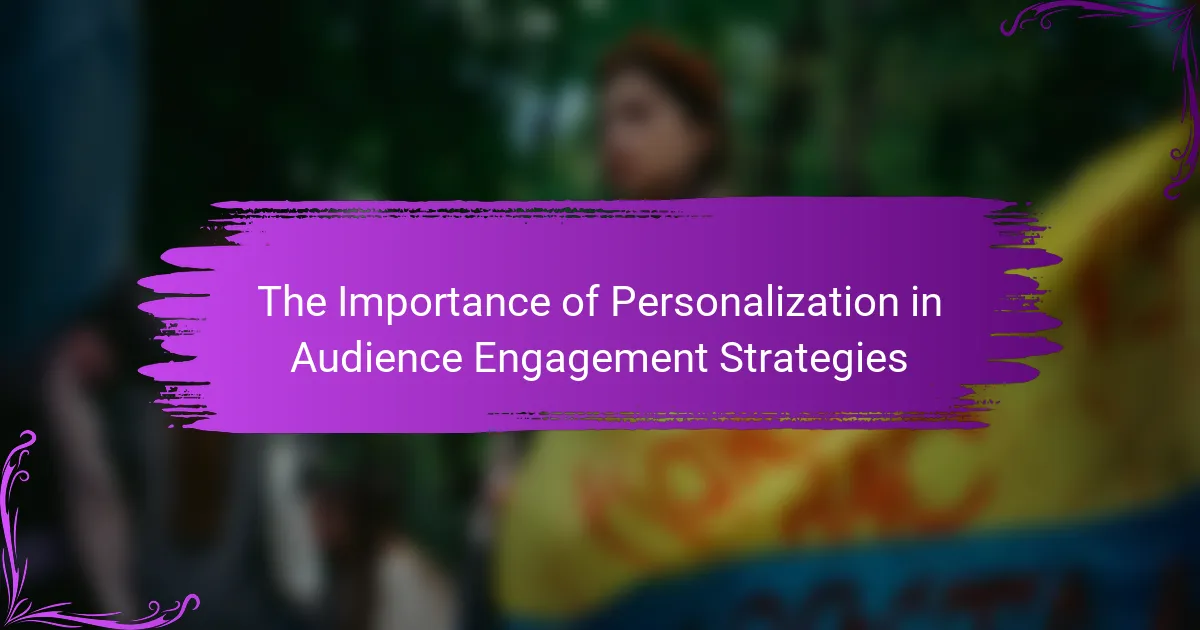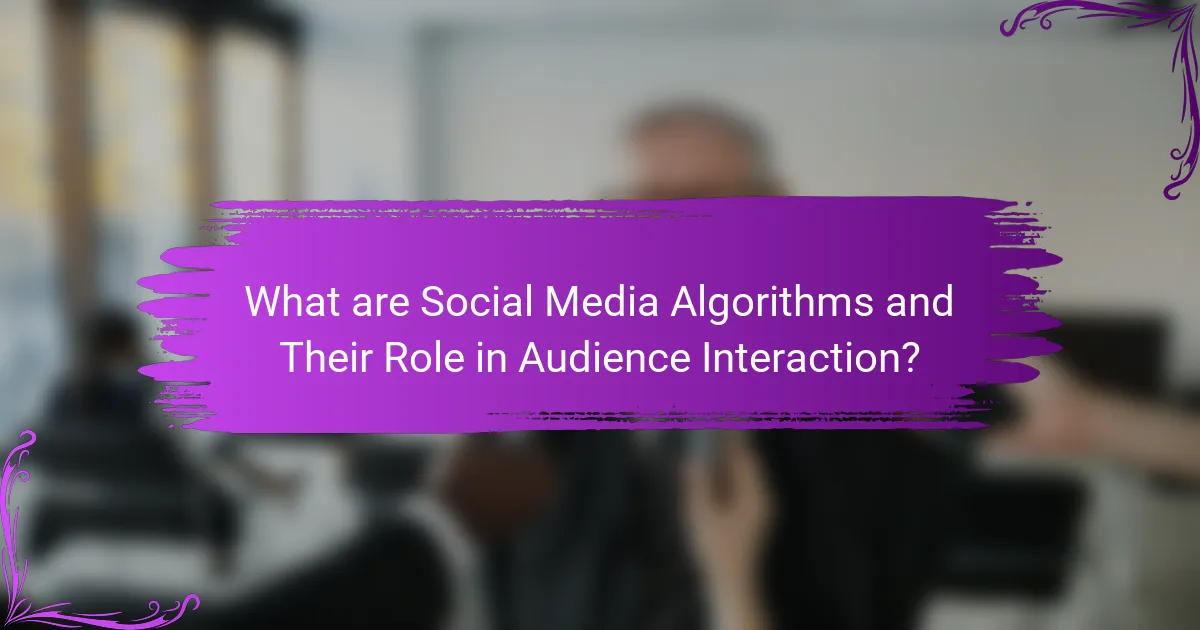
What are Social Media Algorithms and Their Role in Audience Interaction?
Social media algorithms are sets of rules and calculations used by platforms to determine the content shown to users. These algorithms analyze user behavior, preferences, and interactions to curate personalized feeds. They prioritize posts based on factors like engagement, relevance, and recency. This personalization enhances user experience by displaying content aligned with individual interests. For instance, Facebook’s algorithm considers likes, shares, and comments to decide which posts appear first. Research shows that effective algorithms can increase user engagement significantly. A study by Pew Research Center found that 64% of users believe algorithms influence their social media experience. Thus, social media algorithms play a crucial role in shaping audience interaction and content visibility.
How do social media algorithms function in determining content visibility?
Social media algorithms determine content visibility by analyzing user engagement and preferences. These algorithms prioritize content based on factors such as likes, shares, comments, and viewing time. They also consider the relevance of content to individual users, utilizing machine learning to predict what users will find interesting. Each platform employs unique algorithms tailored to its audience and content type. For instance, Facebook uses an algorithm called EdgeRank, which weighs interactions to rank posts in users’ feeds. Similarly, Instagram’s algorithm emphasizes recent engagement and relationships. Studies show that posts with higher engagement rates are more likely to be shown to a broader audience. This mechanism helps platforms retain user interest and enhance interaction.
What factors influence the decision-making process of these algorithms?
The decision-making process of social media algorithms is influenced by several key factors. User engagement metrics play a crucial role. These metrics include likes, shares, comments, and time spent on posts. Algorithms prioritize content that generates higher engagement. Content relevance is another significant factor. Algorithms assess how well content matches user interests and preferences. User behavior history also impacts decision-making. Algorithms analyze past interactions to predict future preferences. Additionally, trending topics and current events influence content visibility. Algorithms often promote content related to popular discussions. Finally, platform-specific guidelines shape algorithmic decisions. These guidelines dictate what types of content are favored or suppressed.
How do user behaviors impact algorithm performance?
User behaviors significantly impact algorithm performance by influencing how content is ranked and displayed. Algorithms analyze user interactions such as likes, shares, and comments to determine content relevance. High engagement rates signal to the algorithm that content is valuable. Consequently, content with more interactions is prioritized in user feeds. For instance, a study by Facebook revealed that posts with higher engagement receive increased visibility. Additionally, user behaviors can lead to feedback loops. When users engage with specific content types, algorithms adapt to show similar content. This can create echo chambers, affecting the diversity of information users receive. Overall, user behaviors directly shape algorithm outcomes, impacting what content is seen and how it performs.
Why are social media algorithms significant for audience engagement?
Social media algorithms are significant for audience engagement because they determine the content users see. These algorithms analyze user behavior, preferences, and interactions. They prioritize posts that are likely to resonate with individual users. This personalization increases the likelihood of user interaction, such as likes, shares, and comments. According to a study by Pew Research Center, 64% of Americans say social media helps them stay informed. Engaging content leads to longer time spent on platforms, enhancing overall user experience. Thus, effective algorithms boost audience engagement by delivering relevant content tailored to users’ interests.
What are the potential benefits of optimized algorithms for users?
Optimized algorithms provide users with personalized content that enhances their experience. These algorithms analyze user behavior to tailor recommendations. This leads to increased engagement as users find relevant content more easily. Additionally, optimized algorithms can improve content discovery, allowing users to explore new interests. Faster processing times result in reduced loading times for content. This efficiency contributes to a smoother user experience. Furthermore, data-driven insights enable platforms to refine their offerings continuously. Studies show that platforms utilizing optimized algorithms see higher user satisfaction rates.
How do algorithms shape the overall user experience on social media platforms?
Algorithms shape the overall user experience on social media platforms by determining the content users see. They analyze user behavior, preferences, and interactions. This data helps platforms curate personalized feeds. Personalized feeds increase user engagement and satisfaction. Algorithms prioritize posts based on relevance and timeliness. This means users are more likely to see content that interests them. Research shows that tailored content can enhance user retention. For instance, a study by the Pew Research Center found that 64% of users feel more connected due to personalized recommendations. Thus, algorithms significantly influence how users interact with social media.
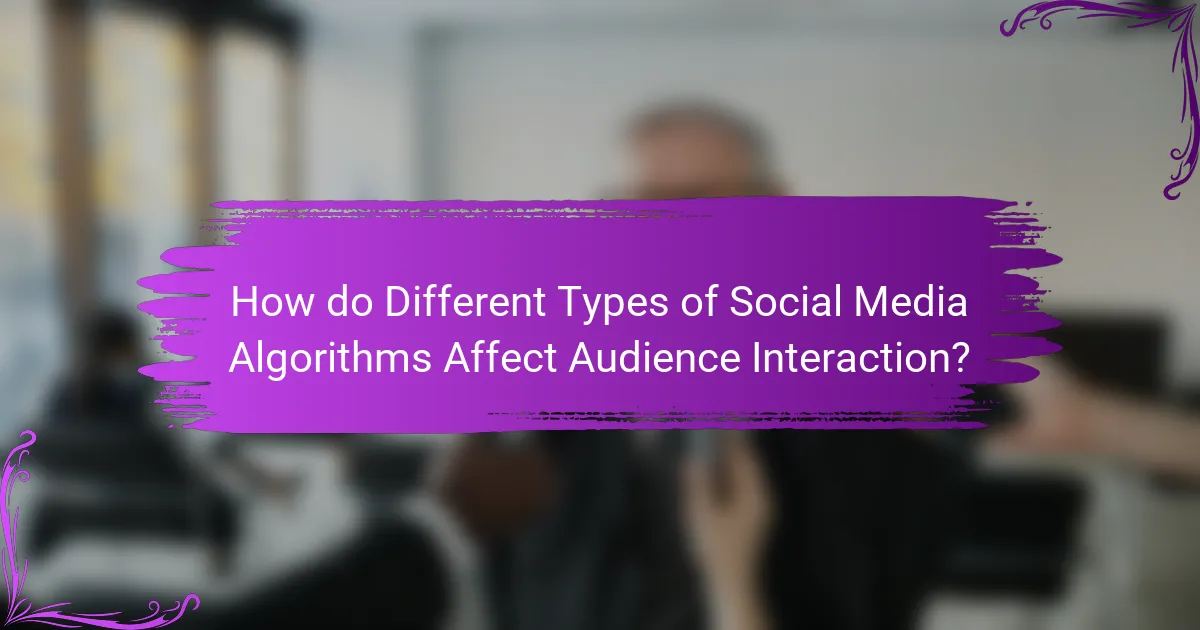
How do Different Types of Social Media Algorithms Affect Audience Interaction?
Different types of social media algorithms significantly influence audience interaction. These algorithms determine what content users see based on their preferences and behaviors. For instance, engagement-based algorithms prioritize posts with high likes, comments, and shares. This can lead to increased interaction for popular content. Conversely, chronological algorithms display posts in the order they were published. This approach can enhance real-time engagement but may reduce visibility for less popular posts. Additionally, recommendation algorithms suggest content based on user interests, potentially increasing interaction by presenting users with relevant posts. Research shows that algorithms can create echo chambers, affecting the diversity of content users engage with. According to a study by Bakshy et al. (2015), algorithmic filtering can lead to a narrower range of perspectives in users’ feeds, impacting overall interaction quality.
What are the various types of algorithms used across social media platforms?
Social media platforms utilize various types of algorithms to manage content. These include recommendation algorithms, ranking algorithms, and engagement algorithms. Recommendation algorithms suggest content based on user preferences and behaviors. Ranking algorithms determine the order of posts in a user’s feed. Engagement algorithms analyze user interactions to enhance content visibility. Each algorithm aims to improve user experience and increase interaction. Data from a 2021 Pew Research study shows that 64% of users feel algorithms influence what they see. This demonstrates the significant role algorithms play in shaping audience interaction on social media.
How does recommendation-based algorithm differ from engagement-based algorithm?
Recommendation-based algorithms prioritize suggesting content based on user preferences and past behavior. They analyze data such as previous interactions, likes, and shares to tailor suggestions. In contrast, engagement-based algorithms focus on maximizing user interaction with content. They prioritize posts that generate high engagement metrics like comments, shares, and likes, regardless of individual user preferences.
Recommendation algorithms aim to personalize user experience, while engagement algorithms aim to increase overall platform activity. Research shows that personalized recommendations can lead to a 10-30% increase in user satisfaction. Engagement algorithms can lead to content going viral due to their focus on popular posts. Both algorithms serve different purposes in enhancing user interaction on social media platforms.
What role do machine learning algorithms play in audience interaction?
Machine learning algorithms play a crucial role in audience interaction by personalizing content delivery. They analyze user behavior, preferences, and engagement patterns. This analysis allows algorithms to recommend relevant content to users. For example, platforms like Facebook and Instagram use these algorithms to curate feeds. They enhance user experience by showing posts that align with individual interests. Research indicates that personalized content increases user engagement significantly. A study by the Pew Research Center found that 64% of users feel more connected when they receive tailored content. Thus, machine learning algorithms directly influence how audiences interact with social media platforms.
How do different platforms implement their algorithms?
Different platforms implement their algorithms based on unique objectives and user engagement strategies. For instance, Facebook uses a ranking algorithm that prioritizes content based on user interactions, such as likes and comments. Instagram employs a similar approach, focusing on post engagement and recency to determine visibility in user feeds. TikTok’s algorithm leverages machine learning to analyze user behavior, promoting content that aligns with individual interests. Twitter utilizes an algorithm that curates tweets based on relevance and user engagement patterns. Each platform’s implementation reflects its goals for maximizing user interaction and content discovery. These methodologies are supported by extensive data analysis and user feedback, ensuring continuous optimization of the algorithms.
What unique attributes do Facebook, Instagram, and Twitter algorithms possess?
Facebook’s algorithm prioritizes content based on user interactions, showing posts from friends and family first. It utilizes machine learning to predict what users will engage with. Instagram’s algorithm emphasizes visual content, favoring posts with high engagement rates. It also considers the recency of posts and user preferences. Twitter’s algorithm is unique in its focus on real-time updates, showing tweets based on relevance and timeliness. It curates content from users’ networks and trending topics. Each algorithm employs distinct strategies tailored to their platform’s user behavior and content format.
How do platform-specific algorithms influence audience behavior differently?
Platform-specific algorithms significantly influence audience behavior by tailoring content to user preferences. Different platforms prioritize various types of engagement, such as likes, shares, or comments. For instance, Instagram emphasizes visual content, leading users to engage more with images and videos. In contrast, Twitter focuses on real-time updates, prompting users to interact with trending topics and news.
These algorithms analyze user interactions to predict future behavior. Facebook’s algorithm, for example, promotes content that generates meaningful interactions among friends and family. This approach fosters a sense of community but may create echo chambers.
Research shows that algorithms can also influence the time spent on platforms. A study by the Pew Research Center found that users on TikTok often spend longer periods engaging with short-form videos. This is due to the platform’s algorithm, which continuously recommends new content based on user activity.
Overall, the differences in algorithms across platforms create unique audience behaviors and engagement patterns. Each platform’s specific focus shapes how users consume and interact with content.
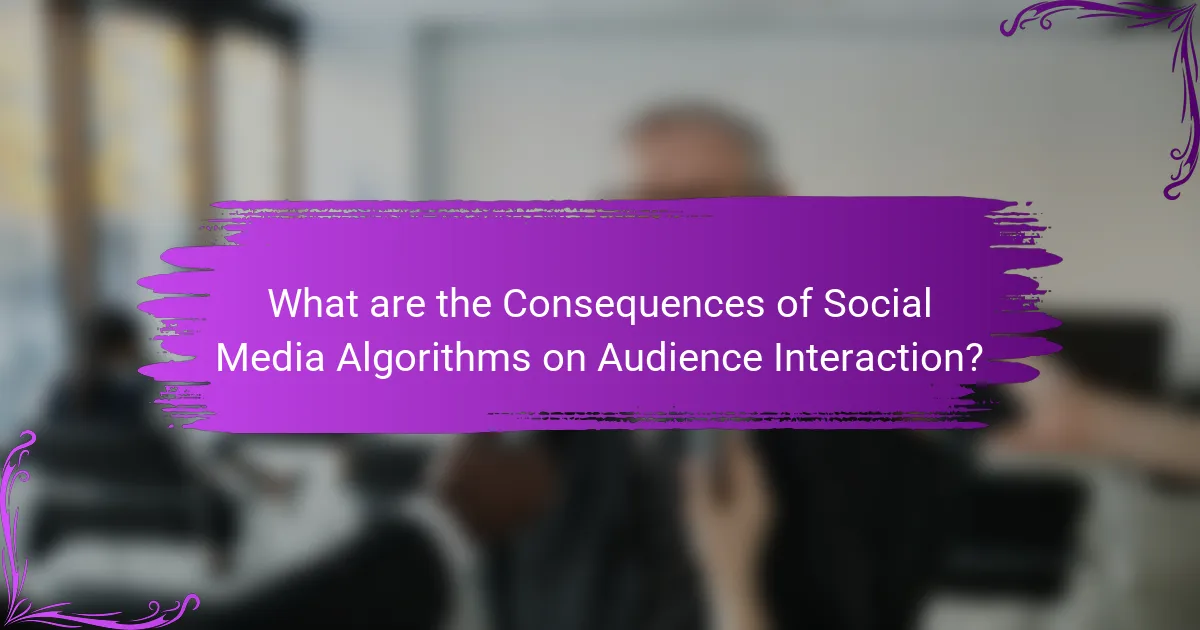
What are the Consequences of Social Media Algorithms on Audience Interaction?
Social media algorithms significantly influence audience interaction by prioritizing content based on user engagement. These algorithms often create echo chambers, where users are exposed mainly to viewpoints that align with their own. This can lead to decreased exposure to diverse perspectives. Additionally, algorithms can promote sensational or polarizing content to maximize clicks and shares. As a result, audience interaction may become more emotionally charged and less rational. Research shows that algorithmic bias can skew public discourse, impacting societal norms and behaviors. A study by the Pew Research Center found that 64% of Americans believe social media has a mostly negative effect on the way things are going in the country today.
What negative impacts can arise from algorithm-driven content curation?
Algorithm-driven content curation can lead to several negative impacts. One significant issue is the creation of echo chambers. These occur when algorithms prioritize content that aligns with users’ existing beliefs. Consequently, users may be exposed to a narrow range of perspectives. This can hinder critical thinking and reduce exposure to diverse viewpoints.
Another impact is the potential for misinformation spread. Algorithms may promote sensational or misleading content because it generates higher engagement. This can lead to users sharing false information widely. A study by the Massachusetts Institute of Technology found that false news spreads faster and reaches more people than true news on social media.
Additionally, algorithm-driven curation can result in decreased user satisfaction. When users receive repetitive or irrelevant content, their engagement may decline. This can lead to frustration and reduced time spent on the platform.
Finally, there is the risk of algorithmic bias. Algorithms can reflect and amplify existing societal biases. This can result in unequal representation of certain groups or ideas in curated content. These negative impacts highlight the complexities of relying on algorithms for content curation.
How do algorithms contribute to echo chambers and filter bubbles?
Algorithms contribute to echo chambers and filter bubbles by prioritizing content that aligns with users’ existing beliefs. They analyze user behavior, such as likes and shares, to tailor feeds. This personalization often excludes diverse viewpoints. As a result, users are less exposed to opposing perspectives. Research shows that platforms like Facebook and Twitter amplify this effect. A study from the Pew Research Center found that 64% of Americans believe social media platforms have a significant role in shaping opinions. Algorithms thus reinforce users’ pre-existing views, creating isolated information environments.
What are the implications of algorithmic bias on audience interaction?
Algorithmic bias negatively impacts audience interaction by skewing content visibility. This bias can lead to unequal representation of diverse viewpoints. Audiences may only see content that aligns with their existing beliefs. This creates echo chambers, limiting exposure to varied perspectives. Research shows that biased algorithms can reinforce stereotypes and misinformation. For instance, a study by ProPublica found that Facebook’s ad targeting had racial biases. Such biases can diminish trust in social media platforms. Ultimately, algorithmic bias affects user engagement and overall satisfaction.
How can users adapt to the changes brought by social media algorithms?
Users can adapt to changes brought by social media algorithms by staying informed about algorithm updates. Regularly reviewing platform guidelines helps users understand how content is prioritized. Engaging consistently with followers can enhance visibility in feeds. Tailoring content to audience preferences increases engagement and shares. Utilizing analytics tools allows users to track performance and adjust strategies. Experimenting with different content formats can reveal what resonates best. Collaborating with other creators can expand reach and diversify content. Lastly, maintaining authenticity fosters trust and loyalty among followers.
What strategies can users employ to enhance their engagement with algorithm-driven content?
Users can enhance their engagement with algorithm-driven content by actively interacting with posts. Liking, sharing, and commenting on content signals to the algorithm that the user finds it relevant. Regularly following accounts that align with personal interests also helps tailor content to preferences. Customizing notification settings ensures users receive updates on preferred topics. Engaging with a diverse range of content can expose users to new interests. Utilizing platform features like polls or Q&A can increase interaction. Consistent engagement over time improves algorithmic recommendations. Research indicates that active participation leads to better content visibility and relevance.
How can content creators optimize their posts for better visibility in algorithmic feeds?
Content creators can optimize their posts for better visibility in algorithmic feeds by focusing on engagement metrics. High engagement signals, such as likes, shares, and comments, improve visibility. Posting consistently increases audience familiarity and interaction. Utilizing relevant hashtags helps categorize content effectively. Creating visually appealing content attracts more attention. Tailoring content to audience preferences enhances relatability. Analyzing performance data allows creators to refine their strategies. Research shows that posts with higher engagement receive more algorithmic promotion.
What best practices should be followed in light of social media algorithms?
To effectively navigate social media algorithms, users should prioritize high-quality, engaging content. Engaging posts encourage user interaction, which algorithms favor. Consistent posting schedules can enhance visibility, as algorithms reward regular activity. Utilizing trending topics can increase reach, as algorithms often promote current content. Hashtags should be relevant and strategically used to improve discoverability. Analyzing audience insights helps tailor content to viewer preferences, aligning with algorithmic preferences. Collaborating with influencers can amplify reach and engagement, leveraging their established audiences. Lastly, responding to comments and messages fosters community, which algorithms recognize positively.
The primary entity of this article is social media algorithms, which are systems used by platforms to curate and prioritize content based on user behavior and engagement. The article examines the role of these algorithms in shaping audience interaction, detailing how they function to determine content visibility and the factors influencing their decision-making processes. It further explores the implications of algorithm-driven content curation, including the potential for echo chambers, algorithmic bias, and the impact on user experience. Additionally, it provides strategies for users and content creators to adapt and enhance engagement within algorithmic frameworks.
